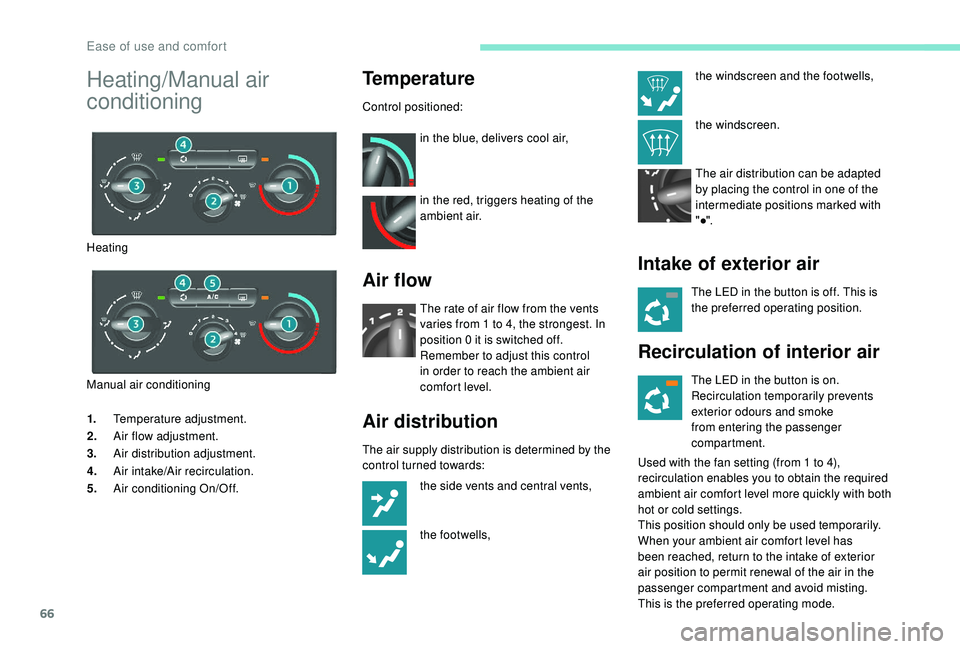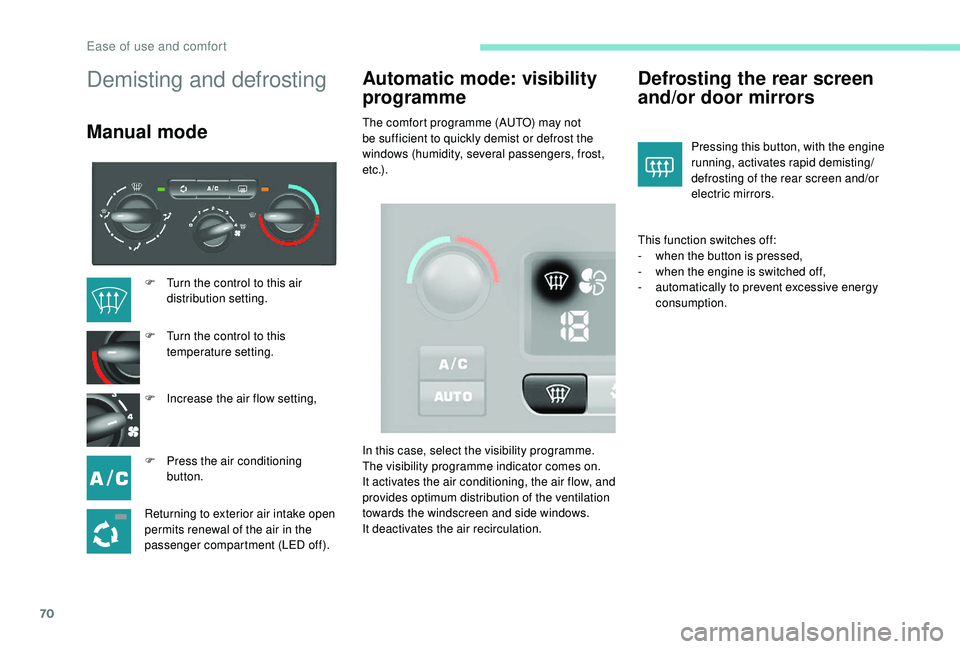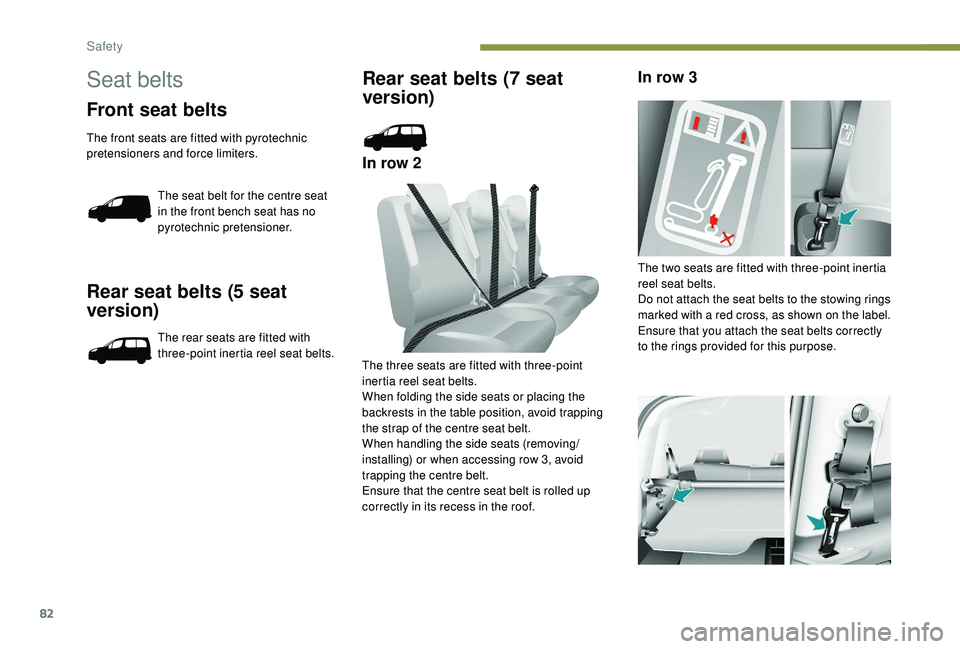2020 PEUGEOT PARTNER TEPEE tow
[x] Cancel search: towPage 68 of 216

66
1.Temperature adjustment.
2. Air flow adjustment.
3. Air distribution adjustment.
4. Air intake/Air recirculation.
5. Air conditioning On/Off.
Temperature
Control positioned:
in the blue, delivers cool air,
in the red, triggers heating of the
ambient air.
Air flow
The rate of air flow from the vents
varies from 1 to 4, the strongest. In
position 0 it is switched off.
Remember to adjust this control
in order to reach the ambient air
comfort level.
Air distribution
The air supply distribution is determined by the
control turned towards: the side vents and central vents,
the footwells,
Intake of exterior air
The LED in the button is off. This is
the preferred operating position.
Recirculation of interior air
The LED in the button is on.
Recirculation temporarily prevents
exterior odours and smoke
from entering the passenger
compartment.
Used with the fan setting (from 1 to 4),
recirculation enables you to obtain the required
ambient air comfort level more quickly with both
hot or cold settings.
This position should only be used temporarily.
When your ambient air comfort level has
been reached, return to the intake of exterior
air position to permit renewal of the air in the
passenger compartment and avoid misting.
This is the preferred operating mode.
Heating/Manual air
conditioning
Heating
Manual air conditioning the windscreen and the footwells,
the windscreen.
The air distribution can be adapted
by placing the control in one of the
intermediate positions marked with
"●".
Ease of use and comfort
Page 70 of 216

68
Manual operation
If you wish, you can make a different choice
from that offered by the system by changing a
setting. The other functions are still managed
automatically. Pressing the AUTO button
returns the system to full automatic operation.
Air distribution
Press this button repeatedly to direct
the air flow towards:
-
t
he windscreen,
-
t
he windscreen and the footwells,
-
t
he footwells,
-
t
he side vents, central vents and footwells,
-
t
he side vents and central vents,
Air flow
F Press the small fan button to
reduce air flow or the large fan
button to increase air flow.
The fan blades fill up in the screen, as the flow
rate increases.
Deactivating the system
F Press the small fan air flow
button until the fan symbol
disappears from the screen.
This will deactivate all system functions except
air recirculation and rear screen defrost (if your
vehicle is so equipped). Your comfort setting is
no longer maintained and disappears from the
screen.
For your comfort, avoid staying in the
deactivated position. Pressing the large fan button or the
AUTO button again reactivates the
system with the values set before
the deactivation.
Intake of exterior air/
Recirculation of interior air
F Press this button to recirculate the interior air. The recirculation
symbol is displayed.
Recirculation temporarily prevents exterior
odours and smoke from entering the passenger
compartment. Avoid prolonged operation in
interior air recirculation mode (risk of misting,
odour and humidity).
Pressing this button again activates the intake
of exterior air.
Air conditioning On/Off
F Once this button is pressed, the A/C symbol will be displayed
and the air conditioning
activated.
Pressing this button again stops cooling of the air.
The ventilation outlet located in the
glove box diffuses fresh air (if the air
conditioning is activated), regardless
of the temperature setting in the
passenger compartment and the exterior
temperature.
Ease of use and comfort
Page 71 of 216

69
Recommendations for ventilation and air conditioning
In order for these systems to be fully effective,
follow the operation and maintenance
guidelines below:
F
T
o ensure that the air is distributed evenly,
keep the external air intake grilles at the
base of the windscreen, the nozzles, the
vents, the air outlets and the air extractor
in the boot free from obstructions.
F
D
o not cover the sunshine sensor,
located on the dashboard; this is used for
regulation of the automatic air conditioning
system.
F
O
perate the air conditioning system for
at least 5 to 10
minutes once or twice a
month to keep it in per fect working order.
F
E
nsure that the passenger compartment
filter is in good condition and have the
filter elements replaced regularly. We
recommend the use of a combined
passenger compartment filter. Thanks to
its special active additive, it contributes
to the purification of the air breathed by
the occupants and the cleanliness of the
passenger compartment (reduction of
allergic symptoms, bad odours and greasy
deposits). If after an extended stop in sunshine, the
interior temperature is very high, first air
the passenger compartment for a few
moments.
Put the air flow control at a setting high
enough to quickly change the air in the
passenger compartment.
The condensation created by the air
conditioning results in a discharge of water
under the vehicle which is per fectly normal.
Depending on version and country
of sale, the air conditioning system
contains fluorinated greenhouse gas
R13 4A
.
Gas capacity: 0.450
kg (+/- 0.025 kg),
GWP index 1,430 t (equivalent CO
2:
0.6 4 4 t).
F
T
o ensure correct operation of the
air conditioning system, you are also
advised to have it checked regularly
as recommended in the Warranty and
Maintenance Record.
F
I
f the system does not produce cold air,
switch it off and contact a PEUGEOT
dealer or a qualified workshop.
When towing the maximum load on a steep
gradient in high temperatures, switching off
the air conditioning increases the available
engine power and so improves the towing
ability.
To avoid the windows misting up and
deterioration in the quality of the air:
-
d
o not drive for too long with the
ventilation switched off.
-
d
o not keep air recirculation set for an
extended period.
Stop & Star t
The heating and air conditioning systems
only work when the engine is running.
Temporarily deactivate the Stop &
Start system to maintain a comfortable
temperature in the passenger
compartment.
For more information on Stop & Star t,
refer to the corresponding section.
3
Ease of use and comfort
Page 72 of 216

70
Demisting and defrosting
Manual modeAutomatic mode: visibility
programmeThe comfort programme (AUTO) may not
be sufficient to quickly demist or defrost the
windows (humidity, several passengers, frost,
e t c .) .
Defrosting the rear screen
and/or door mirrors
Pressing this button, with the engine
running, activates rapid demisting/
defrosting of the rear screen and/or
electric mirrors.
This function switches off:
-
w
hen the button is pressed,
-
w
hen the engine is switched off,
-
a
utomatically to prevent excessive energy
consumption.
F
T
urn the control to this air
distribution setting.
F
T
urn the control to this
temperature setting.
F
I
ncrease the air flow setting,
F
P
ress the air conditioning
button.
Returning to exterior air intake open
permits renewal of the air in the
passenger compartment (LED off). In this case, select the visibility programme.
The visibility programme indicator comes on.
It activates the air conditioning, the air flow, and
provides optimum distribution of the ventilation
towards the windscreen and side windows.
It deactivates the air recirculation.
Ease of use and comfort
Page 73 of 216

71
Lighting control stalk
Front and rear lamps
Lamps off
Lamps with automatic illumination
Sidelamps
Dipped headlamps (green)
Main beam (blue)
Switching between dipped and
main beam
F Pull the stalk fully towards you.
Reminder, lamps on
When switching off the ignition, all of the lamps
turn off, except for dipped beam if the guide-
me-home lighting is activated.
F
T
o activate the lighting control stalk, set the
ring to position 0 (lamps off), then to the
desired position.
When the driver's door is opened, if the lamps
are on, an audible signal will sound.
To avoid discharging the battery, the Economy
mode is triggered after thirty minutes without
any action by the user. The functions are put on
standby and the battery warning lamp flashes.
The sidelamps are not affected by the
Economy mode.
For more information on the Economy
mode , refer to the corresponding section.
Front and rear foglamps
These work with the sidelamps and dipped
headlamps.
They are selected by rotating the ring for wards to
switch on and to the rear to switch off.
The state is indicated by the indicator lamp in the
instrument panel.
Front foglamps (green, the ring is
turned forwards once).
Rear foglamps (amber, the ring is
turned for wards twice).
To turn the rear and front foglamps off, turn the
ring twice to the rear.
In clear weather or in rain, both day and
night, rear foglamps dazzle and their use
is prohibited.
Do not forget to switch them off when they
are no longer necessary.
Automatic illumination of headlamps
switches the rear foglamps off, but the
front foglamps stay on.
Selection is made by rotating this ring.
4
Lighting and visibility
Page 76 of 216

74
Manual wiping
2Fast wiping (heavy rain).
1 Normal wiping (moderate rain).
I Intermittent wiping.
0 Of f.
â Single wipe
(press downwards).
In I ntermittent position, the wiping frequency is
proportional to the speed of the vehicle.
After the ignition has been switched off for
more than a minute, with the wiper control
stalk in position 2, 1 or I, the control must be
reactivated.
-
M
ove the control to any position.
-
S
witch it to the desired position.
Automatic windscreen
wipers
Do not obstruct the rain sensor,
located in the centre of the
windscreen, behind the rear view
m i r r o r.
In AUTO position, the wipers operate
automatically and adapt their speed to the
intensity of the rain. Activation
F
P
ress the control downwards. Activation of
the function is accompanied by a message
on the screen.
If the ignition has been off for more than one
minute, the automatic rain sensitive windscreen
wipers must be reactivated by pushing the
control stalk downwards.
Deactivation
F
P
lace the wiper control stalk in position I
, 1
or 2 .
Deactivation of the function is accompanied by
a message on the screen.
If a fault occurs with the automatic rain
sensitive wipers, the wipers will operate in
intermittent mode.
Contact a PEUGEOT dealer or a qualified
workshop to have the system checked.
During an automatic wash, turn off the
ignition to avoid automatic wiping being
triggered.
In winter, it is advisable to wait until the
windscreen is completely clear of ice before
activating the automatic rain sensitive wipers.
F Pull the control towards you, the screenwash action will be accompanied by
a timed operation of the wipers.
Windscreen washer
This fluid level should be checked
regularly, particularly during winter.
For more information on Checking levels
and, in particular, the screenwash, refer to
the corresponding section.
Special position of the
windscreen wipers
Operate the wiper stalk within one minute after
switching off the ignition to position the wiper
blades along the windscreen pillars.
This action allows the wipers to be taken up for
winter parking, cleaning or replacement.
For more information on Changing a
wiper blade , refer to the corresponding
section.
To return the wiper blades to the normal
position, switch on the ignition and operate the
wiper stalk.
Lighting and visibility
Page 84 of 216

82
Rear seat belts (5 seat
version)
The rear seats are fitted with
three-point inertia reel seat belts.
Rear seat belts (7 seat
version)
In row 2In row 3
The three seats are fitted with three-point
inertia reel seat belts.
When folding the side seats or placing the
backrests in the table position, avoid trapping
the strap of the centre seat belt.
When handling the side seats (removing/
installing) or when accessing row 3, avoid
trapping the centre belt.
Ensure that the centre seat belt is rolled up
correctly in its recess in the roof. The two seats are fitted with three-point inertia
reel seat belts.
Do not attach the seat belts to the stowing rings
marked with a red cross, as shown on the label.
Ensure that you attach the seat belts correctly
to the rings provided for this purpose.
Seat belts
Front seat belts
The front seats are fitted with pyrotechnic
pretensioners and force limiters.
The seat belt for the centre seat
in the front bench seat has no
pyrotechnic pretensioner.
Safety
Page 86 of 216

84
Advice
The driver must ensure that passengers use
the seat belts correctly and that they are all
fastened before setting off.
Wherever you are seated in the vehicle,
always fasten your seat belt, even for short
journeys.
Do not interchange the seat belt buckles as
they will not fulfil their role fully.
The seat belts are fitted with an inertia reel
permitting automatic adjustment of the length
of the strap to your size. The seat belt is
stowed automatically when not in use.
Before and after use, ensure that the seat belt
is reeled in correctly.
The lower part of the strap must be positioned
as low as possible on the pelvis.
The upper part must be positioned in the
hollow of the shoulder.
The inertia reels have a device for automatic
locking in the event of a collision, sudden
braking or if the vehicle turns over. You can
release the device by pulling the strap firmly
and then releasing it so that it reels in slightly.In order to be effective, a seat belt must:
-
b e tightened as close to the body as
possible,
-
b
e pulled in front of you with a smooth
movement, checking that it does not twist,
-
b
e used to restrain only one person,
-
n
ot show any signs of cuts or fraying,
-
n
ot be converted or modified to avoid
affecting its performance.
In accordance with current safety regulations,
for all repairs on your vehicle's seat belts, go
to a qualified workshop with the skills and
equipment needed, which a PEUGEOT dealer
is able to provide.
Have your seat belts checked regularly by a
PEUGEOT dealer or a qualified workshop,
particularly if the straps show signs of
damage.
Clean the seat belt straps with soapy water or
a textile cleaning product, sold by PEUGEOT
dealers.
After folding or moving a seat or rear bench
seat, ensure that the seat belt is positioned
and reeled in correctly. Recommendations for children
Use a suitable child seat if the passenger is
less than 12
years old or shorter than one and
a half metres.
Never use the same seat belt to secure more
than one person.
Never allow a child to travel on your lap.
For more information on Child seats , refer to
the corresponding section.
In the event of an impact
Depending on the nature and seriousness
of the impact , the pyrotechnic device may
be deployed before and independently of the
airbags. Deployment of the pretensioners
is accompanied by a slight discharge of
harmless smoke and a noise, due to the
activation of the pyrotechnic cartridge
incorporated in the system.
In all cases, the airbag warning lamp comes
on.
Following an impact, have the seat belts
system checked and, if necessary, replaced,
by a PEUGEOT dealer or a qualified
workshop.
Safety